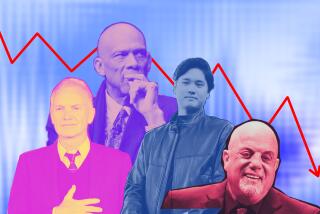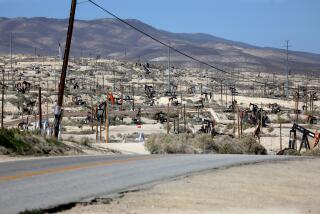The death of the ‘Millionaire Next Door’ dream
- Share via
The idea that the average guy can become rich via hard work and rigorously virtuous thrift is one of the compelling myths of the American experience.
But for the most part, myth it is. Two recent events are both driving it forward and exposing its basic phoniness. The first is the death last week of Thomas J. Stanley, coauthor of the bestselling book “The Millionaire Next Door,” in a car accident. The other is the death of one Ronald Read, a Vermont retiree who appeared to be one of Stanley’s emblematic secret blue-collar millionaires -- after a lifetime of low-wage menial work and frugal living, he was discovered to have amassed a fortune worth about $8 million.
Let’s take them in turn.
Stanley’s 1996 book, co-written with William D. Danko, defined the “prototypical” American millionaire not as an ostentatious Gatsby or Trump but as the proprietor of a “dull-normal” small business -- “welding contractors, auctioneers, rice farmers, owners of mobile-home parks, pest controllers, coin and stamp dealers, and paving contractors.” His (mostly) or her median income was $131,000, and median net worth $1.6 million.
“We wear inexpensive suits and drive American made cars,” the book said in the voice of its putative heroes. “Only a minority of us drive the current-model-year automobile.”
But as Helaine Olen points out in the most clear-eyed valedictory to the late Stanley, his book “was already describing a vanishing world when it was published.” Fewer young people starting their careers today have had even the middle-class upbringing or family resources of so many of Stanley’s quiet millionaires.
That makes a big difference, because it’s rarely appreciated that many small businesses start with family investments. Remember Mitt Romney? As a presidential candidate, his advice to young students was: “Take a shot, go for it, take a risk, get the education, borrow money if you have to from your parents, start a business.” But what if your parents don’t have any money?
Olen reminds us that the Stanley millionaire model was a bit fraudulent from the start. Economist Nassim Nicholas Taleb noticed, in his own book, “Fooled by Randomness,” that the picture painted by “The Millionaire Next Door” was the product of survivor bias -- “the authors made no attempt to correct their statistics with the fact that they saw only the winners,” he wrote. What of the millions of investors who invested in the wrong things or whose paving companies failed? They outnumber the winners by a large margin.
Taleb also observed that the book reflected “an unusual episode in history” when the return on assets was astronomical in historical terms. It arrived when that episode was playing out. Only three years after its publication came the dot-com crash; less than a decade later came the 2008 crash and a grinding recession that consigned lots of formerly million-dollar small businesses to oblivion.
That brings us to Ronald Read, who died in June at the age of 92 in Brattleboro, Vt., and was soon discovered to own a safe deposit box stuffed with stock certificates and other investments totaling $8 million. The news broke last month, after it was learned that he had bequeathed millions to his local library and hospital.
There’s no doubt that Read’s accumulation of wealth from a lifetime of work as a service station hand and later an employee of his local JCPenney was an exceptional achievement. On CNBC, a panel of investment types praised his “strategy,” which appeared to consist of buying dividend-yielding blue chips, leaving them alone and spending little on himself.
But it’s hard to know what life lessons one should draw from Read’s experience. In part that’s because his life story already has been subjected to a certain amount of caricature. He was frugal but not the isolated loner who never spent a dime, as he’s sometimes depicted.
Read’s one marriage, at 38, brought him two teenage stepchildren, who he moved into a Brattleboro home he bought for about $12,000 (in the early 1960s) and supported through college. “He was a super good stepdad,” his stepson, Phillip Brown, 70, told me this week. He “never really took a vacation,” Brown says, and remained healthy well into his 80s.
One of CNBC’s analysts suggested that Read’s success could be replicated by merely investing $300 a month and letting it ride for 65 years; at an 8% compounded investment yield, that sum would grow to $8 million. That seems doable on the surface, but could it be done by a low-income laborer starting today? It’s extremely doubtful.
For one thing, as the investment website Philosophical Economics rightly observes, that $300-a-month investment estimate ignores inflation. “Sixty-five years ago, $300 per month was a very large amount of money.... No janitor on earth would have been able to afford it.”
The website calculates that the required investment was $524 a month in 2015 dollars. That would have been a real challenge for someone in Read’s economic position, so he deserves major props for achieving it through what seems to be genuine discipline in his lifestyle and investment practice.
But the real secret to his success was catching the asset wave that Taleb mentioned. In other words: luck. The period in which he invested started with extreme undervaluations in the equity market. BusinessWeek’s famous (or infamous) “Death of Equities” cover story ran in August 1979. Since then equities have been on a long-term tear; $100 invested at the start of that period would be worth $2,000 today.
But these trend lines occur less than once per lifetime, and ‘70s-vintage rock-bottom valuations, which were themselves the product of a high inflation and interest rate environment, aren’t in place today, when inflation and rates are near historic lows.
Read’s frugality assisted his portfolio in another way. Since he apparently felt no need for the money, he didn’t have to draw it down at various low points -- say in March 2009, after it had lost nearly 60% of its value at year-end 2007. And by not selling, he didn’t incur capital gains taxes, which were extinguished upon his death.
To sum up, we should admire Read for living in a style that suited him and that would eventually benefit at least two deserving nonprofit institutions in his community. But it’s one thing to admire that lifestyle, another to aspire to it.
“The Millionaire Next Door” elevated self-abnegation to an investment rule -- what Thomas Frank, another critic of their book, termed the authors’ “militantly Calvinist attitude toward consumption” in which “saving and investing are ends in themselves, evidence of moral virtue, while spending is empty dissipation.” Olen, among others, mentions the neat irony that Stanley met his end while driving a Corvette, not normally a symbol of asceticism.
Sometimes spending isn’t a choice, either. If Read suffered from poor health during his working years or required long-term care, his estate would be a fraction of what it was.
For the rest of us, saving and investing is an act of deferred gratification -- by waiting, we have more to spend on goods and services that please us. “I see no special heroism in accumulating money,” Taleb wrote, “particularly if, in addition, the person is foolish enough to not even try to derive any tangible benefit from the wealth.... I certainly do not see the point of becoming [a millionaire] if I were to adopt Spartan (even miserly) habits and live in my starter house.”
Keep up to date with the Economy Hub. Follow @hiltzikm on Twitter, see our Facebook page, or email mhiltzik@latimes.com.
More to Read
Inside the business of entertainment
The Wide Shot brings you news, analysis and insights on everything from streaming wars to production — and what it all means for the future.
You may occasionally receive promotional content from the Los Angeles Times.











